Kelmscott Chaucer - Easton Press vs. Bradford Exchange side by side comparison
DiscussionsEaston Press Collectors
Rejoignez LibraryThing pour poster.
1hamletscamaro
Having recently been posted here on LibraryThing that Bradford Exchange has now jumped into the fray with more deluxe edition books by offering their own Kelmscott Chaucer, I decided that it would be interesting to see this for myself and compare their book to Easton Press' version of the same. The Easton offering was the book which started me down the DLE path that many others have also trod (much to the dismay of my bank account).
I took both into my place of work since my house is overrun with both Christmas decorations and family, and since this gave me a larger space to compare them. Below are some photo comparisons between Easton Press' edition, on the left when both are shown, and Bradford Exchange's version shown on the right.
I’ve included some general thoughts and observations. I am no book binding expert, so specific terms may have eluded me, and my photography skills are very rough, but hopefully this gives you some idea.
First, a note on the print run. Easton Press kept their print run true to the original Kelmscott run of 425. EP also randomizes editions sent to customers so you never know if you will get a low number, a high number, or somewhere in between. Bradford Exchange on the other hand decided on a much larger print run of 1896, deciding to honor the year that the Kelmscott Chaucer was released, and most likely try to maximize their profits in the long term. Judging from my low print run number, and the fact that I pre-ordered my book when I first heard about it, my assumption is that they are shipping these sequentially and that you are probably going to get a lower number if you order early. The price on both are almost exactly the same at $600, although of course EP’s book is no longer available and you will pay much more on the secondary market.
These books are both large and heavy. Easton’s is the heavier of the two at 12 lbs., 15.2 oz. (5.841kg), not including the clamshell box. Bradford comes in at 12 lbs., 0.2 oz. (5.443kg). I think this is by and large due to the paper, where Easton uses a denser product. I didn’t take the time to actually measure the dimensions of each book, but both are slightly larger than 11 ½ by 17 inches, and the Bradford book is slightly larger and a bit thicker than its Easton counterpart.
The paper on each is very different. EP uses a very textured product with a definite vertical grain across the page. I can’t be sure, as I am not a paper expert, but I believe that EP uses a heavy linen paper (someone please feel free to correct me on this point). The Bradford book uses a nice thick and heavy paper, but it doesn’t feel as luxurious as the EP product. You can also see that EP shears the fore edge of all of their pages flush and then gilts the edges to seal the book. On the BE book, the pages are rough cut and gilt before binding, which give it that rough cut look on each of the edges. I like each, but each simply takes a different approach. I am not sure what was done with the original Kelmscott books, but as I know most were covered after they left the Kelmscott Press, this will probably also vary widely depending on what the end customer decided to do.
The covers are both nice. You can obviously see that the colors are very different. The BE book is more of a white cream, whereas EP takes a slightly beige with a bit of olive in their leather dye color. The feel of the leather in both is very nice, both feeling about the same.
The stamping on each was a little different. EP has a slightly deeper stamping, and of course uses their normal gold gilt inlay to highlight the detail. The BE book uses an olive colored stamping that almost looks like a wash to bring the detail to life. Some of the stamping depth may have to do with the fact that BE uses wood in their cover, while EP uses a very thick cardboard (one of their thicker DLE covers). I of course haven’t taken the books apart to investigate further.
If you look at the cover detail closely, you will see that each has slightly different detail included in their stamping: EP has a little more details in items like the central grid, while BE has more detail in some of the floral wisps and some of the capital letters. Again, I am not sure which books that they emulated, but the differences might lie there. Also, the BE book had art on the back of the book, whereas the EP back cover is completely plain. I thought that was a very nice addition to the BE book. At first I wondered if Bradford had based their book off of Easton’s edition, but after comparing the details of the two and the slight size difference, this is not the case.
One thing I did note about the BE book, is that the cover color stamping is slightly off register in places which gives a “blurred” effect. This is only very slightly noticeable on some areas on the cover, but there is one of the panels on the spine, the fourth down, that this was quite pronounced. It was obvious that each of these panels was individually stamped or otherwise the entire spine would have been impacted. I have an up close photo of this section.
The leather work itself seemed to be a little more roughly completed on the BE edition. Whereas EP’s book has nice tight joints and corners and the seams were flat, BE’s book had some rougher bends and just appeared a little sloppier. I’ve included an up close photo on one of the worst of the interior corners of the BE book.
The actual binding itself also caught my attention on the Bradford book. The smyth sewn pages were good, I didn’t have any problem with the work there. As mentioned above this gave the pages that rough offset look that I actually like on many books. However, the leather joints that transition the cover to the spine at the top and bottom of the book didn’t bend in the same fashion, which gave each joints a different look and it didn’t look uniform as Easton’s normally always do. Also, the case liner on the interior back of the leather for the spine is not attached to the interior page liner on the page spine. If you press the spine leather, you can feel that there is glue between the two components, but it will slowly pop off again in a few moments. I don’t think this was necessarily a defect, due to the size of the book, the spine is allowed to flex as you open various sections throughout the book, I simply wasn't sure why there was glue between the two spine liners.
One thing that I do really like with the Bradford Exchange book is the clasps that help keep the book tightly bound. The hardware is very tastefully done, and the attachment points are very skillfully finished. You will note from the back cover that there are a cluster of rivets (screws/bolts?) that nicely hold the leather bands to the rear cover. The front cover simply has two small exposed beads that extend from the leather to which the clasp attaches. I can only guess that this bead attaches internally to the cover wood board, but couldn't feel any of the internal hardware, so that was nicely done as well.
Internally, the book printing is almost exactly the same. The EP edition has marbled end pages as pictured, the BE book has the same paper as end sheets as used in the rest of the book. The EP book does have an EP colophon page that points out the Easton specifics. There is no such BE colophon page in the BE book; any Bradford specific information is contained in the loose leaf data, edition and welcome letter contained as inserts. I have attached photos of each. I have not included many photos of the interior pages as printing from both books was very high quality with no discernible issue with either. However, I do humorously note that my edition of the Bradford book contains a few small fingerprint smudges on a couple of the interior pages at the beginning of the book, but this isn’t an issue for me.
The Easton Press Kelmscott of course comes with a large green clamshell box with a matching green ribbon to help lift it from the box. The Bradford Exchange book simply stands alone, no box or cover. The EP book also has the standard EP ribbon book mark, while BE doesn’t include a ribbon.
Overall, I do like the Bradford Exchange book. Yes, I think there are some quality issues which don’t make it a nice as the Easton Press book. However, I do think that Bradford has some very nice aspects that I really appreciated: the clasps, back cover art, cover shading (vs. gold gilt) and the rough cut fore edges of the paper. If you don’t have the Easton Press Chaucer, this might be a good opportunity to pick up an alternative. Will the Bradford book impact the secondary market prices of the EP book? Time will only tell, but the two are clearly different so EP purists may still want the EP version. Also, the larger print run of the Bradford edition will probably help to keep its values a bit lower. Again, I don’t really buy for investment as I do for enjoyment of the book. I haven’t decided if I will keep the Bradford edition.
Hopefully I haven’t droned on too much. Enjoy the photos.
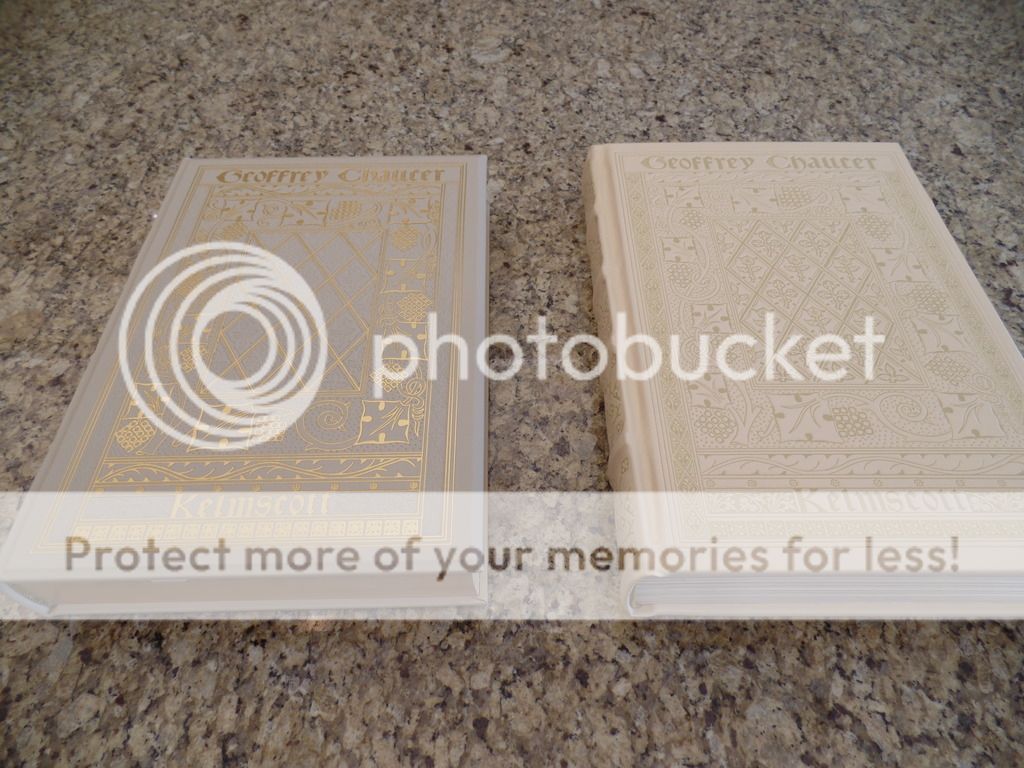
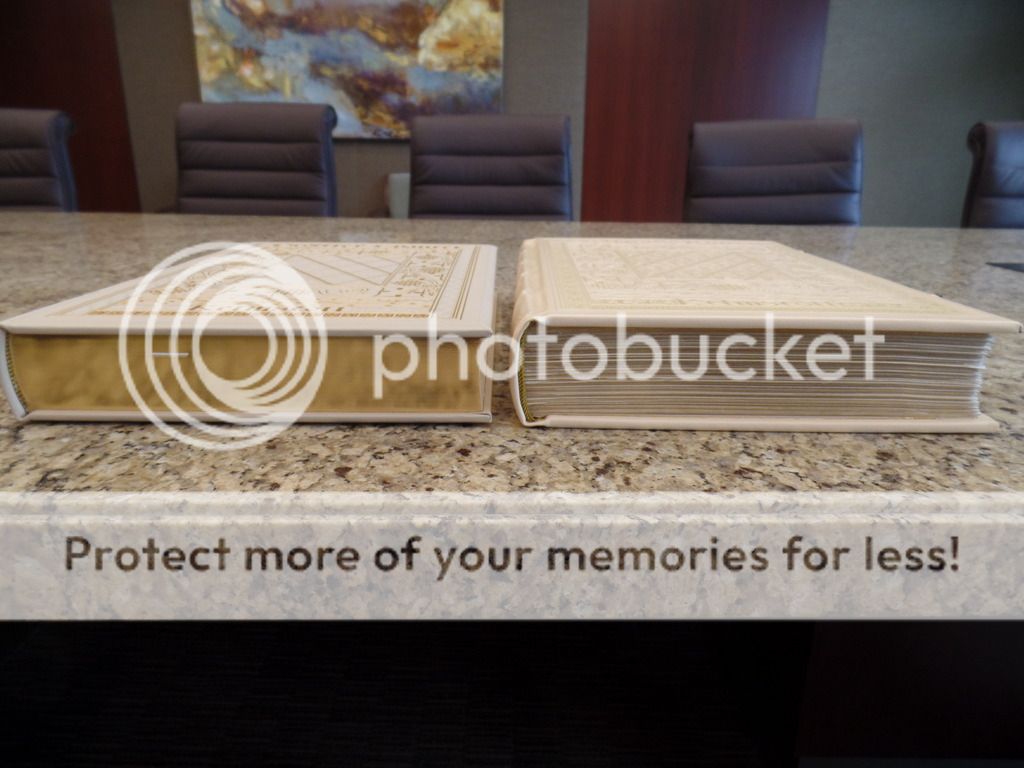

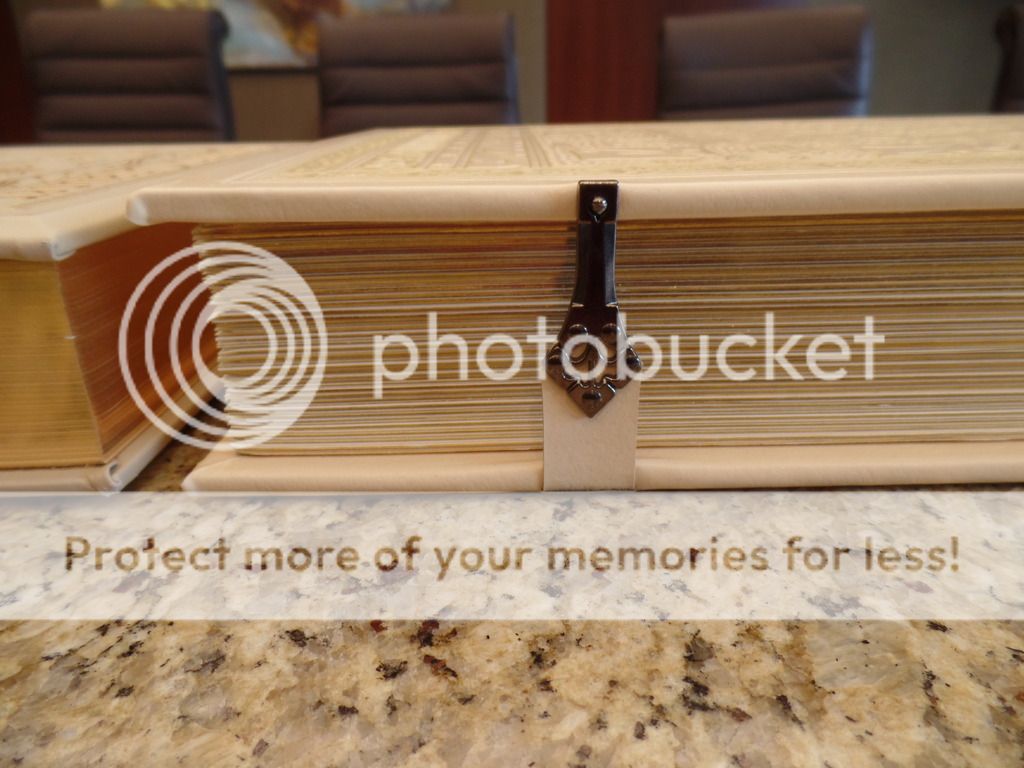
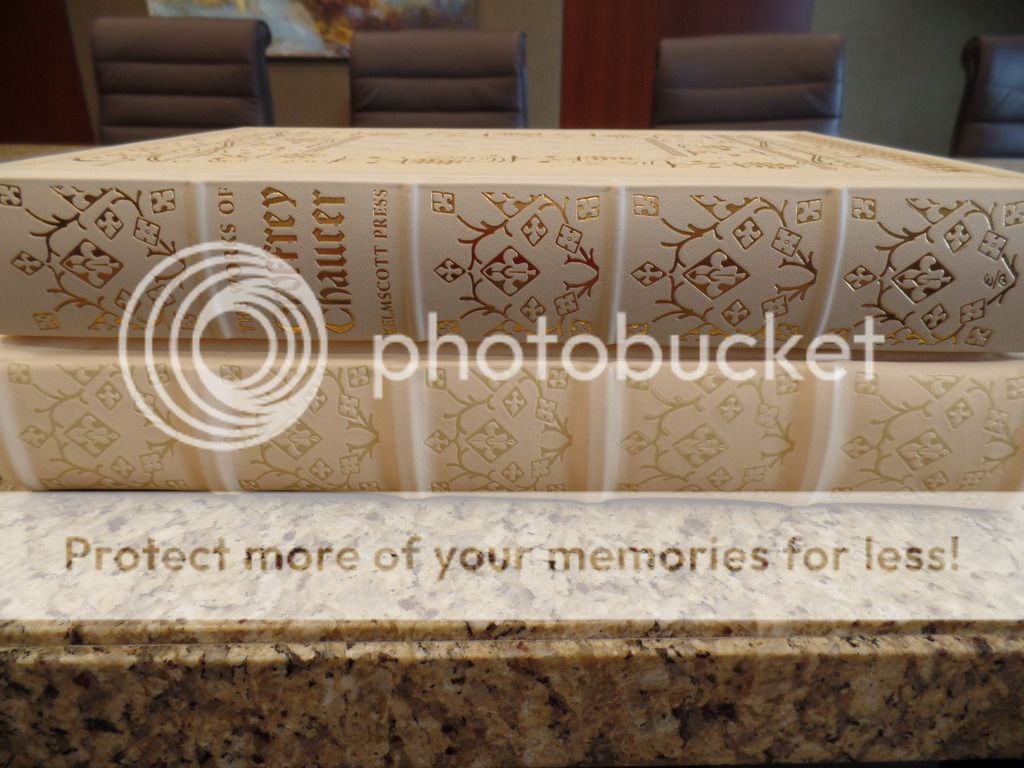
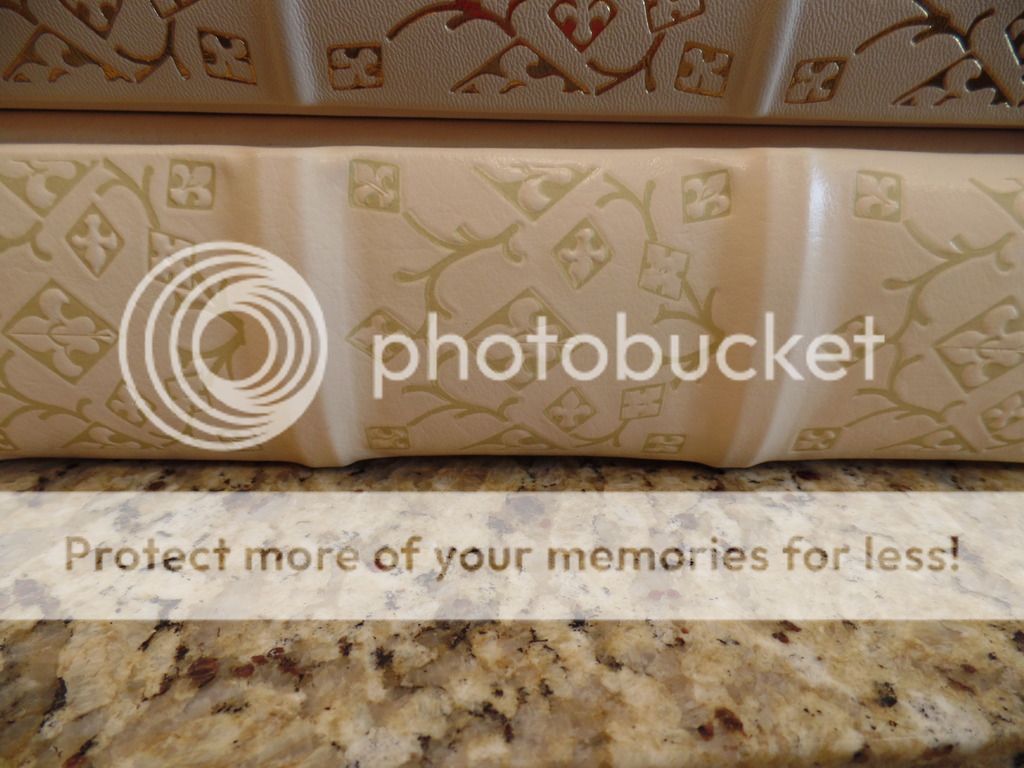
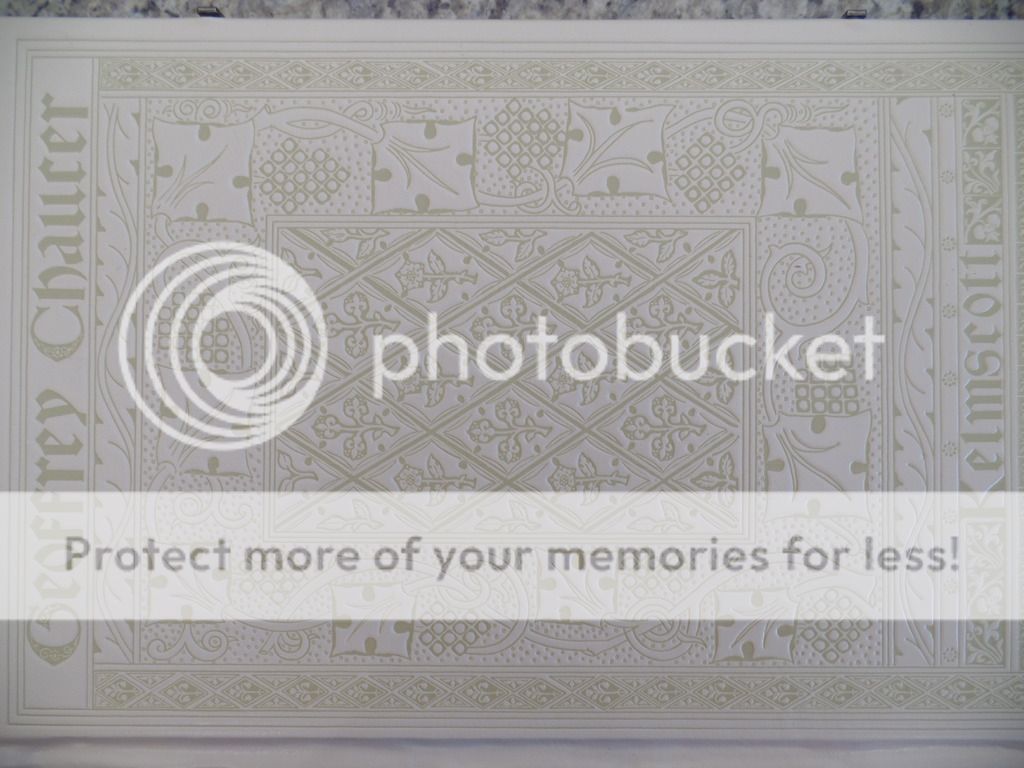
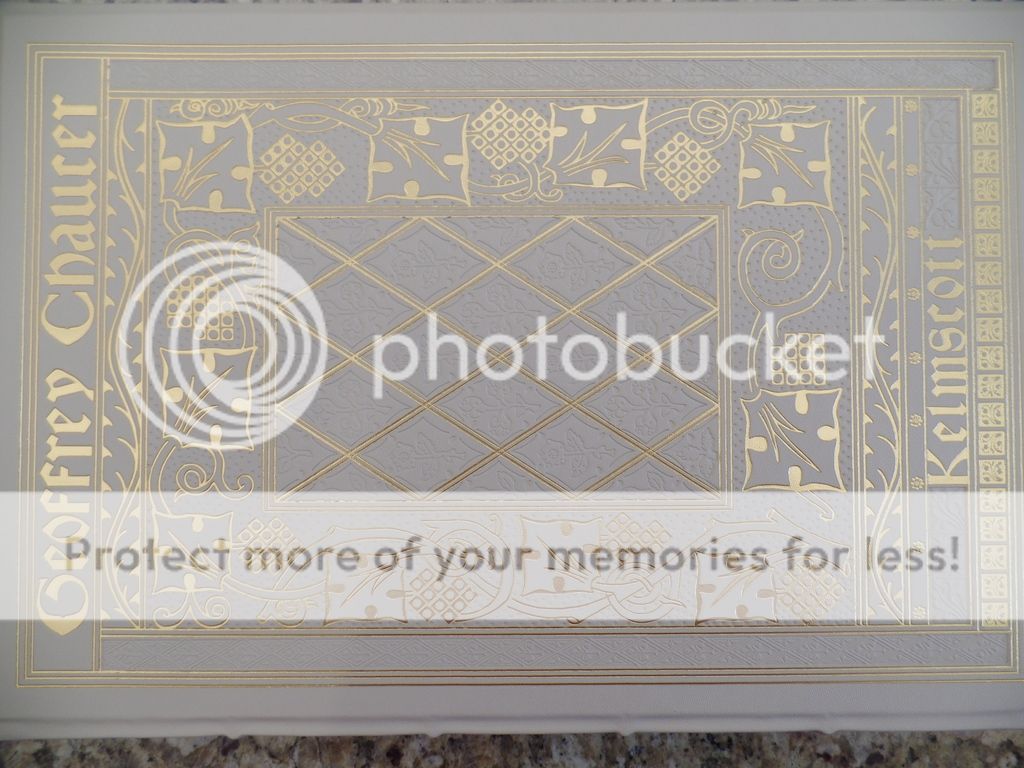

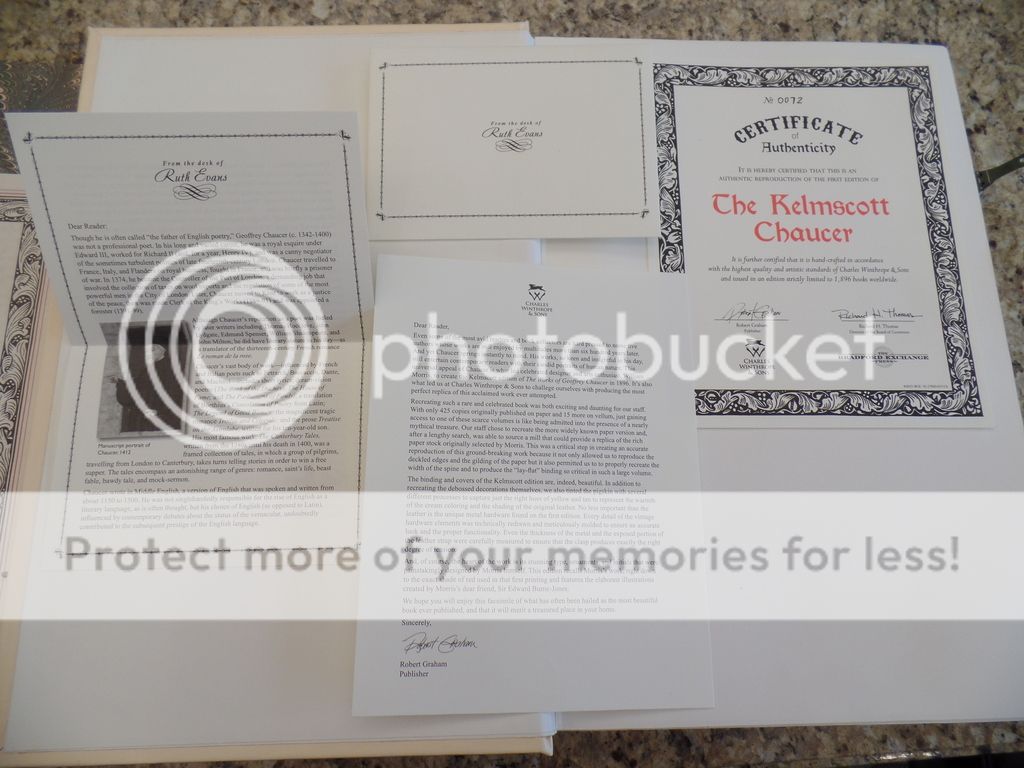
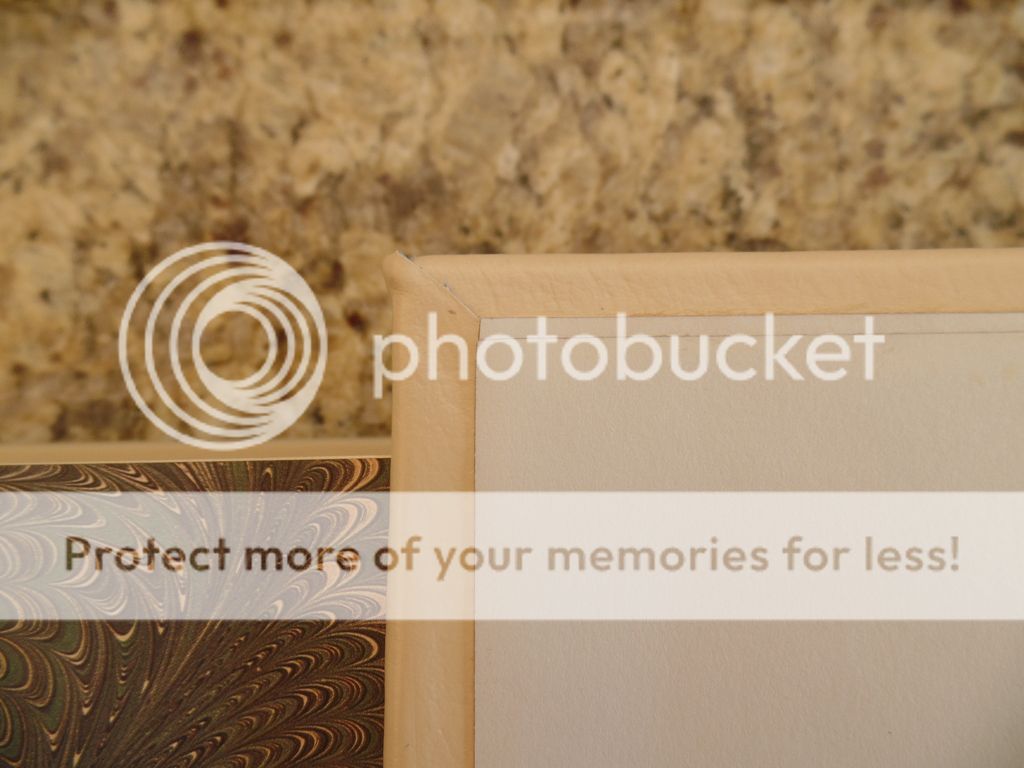

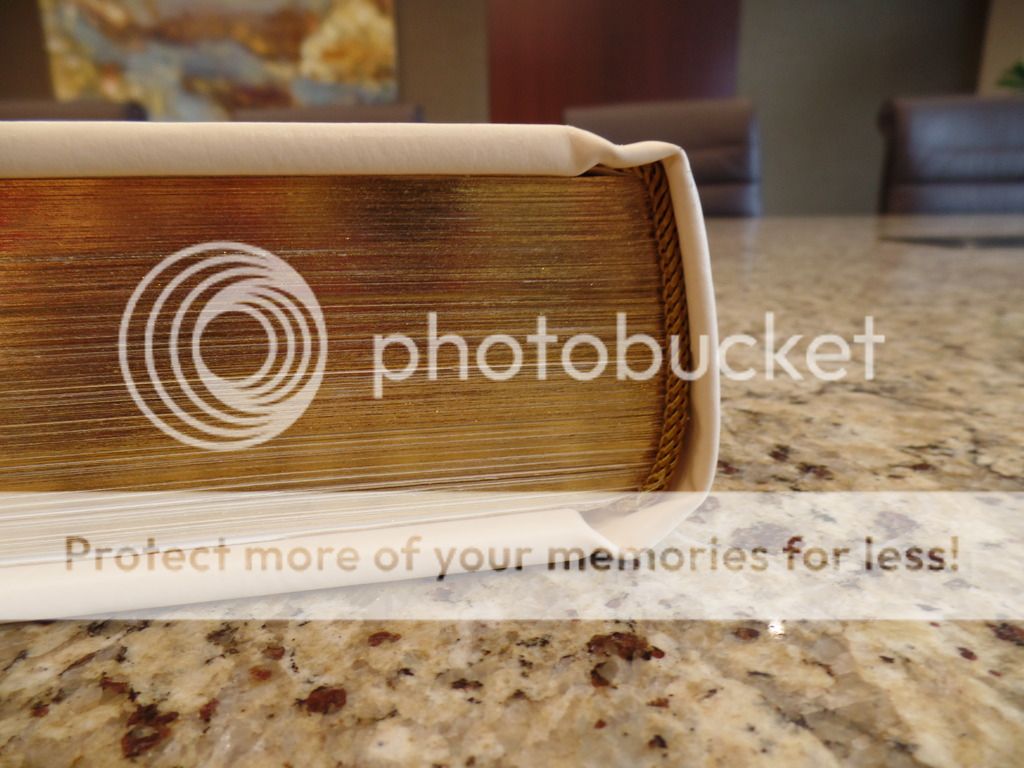
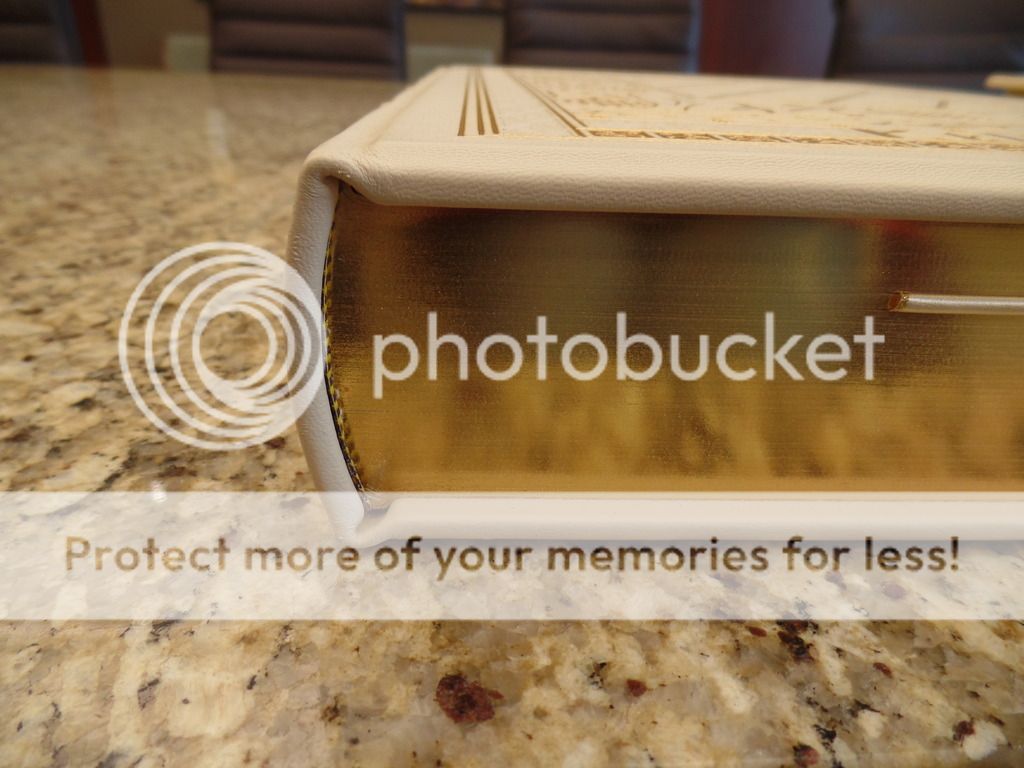
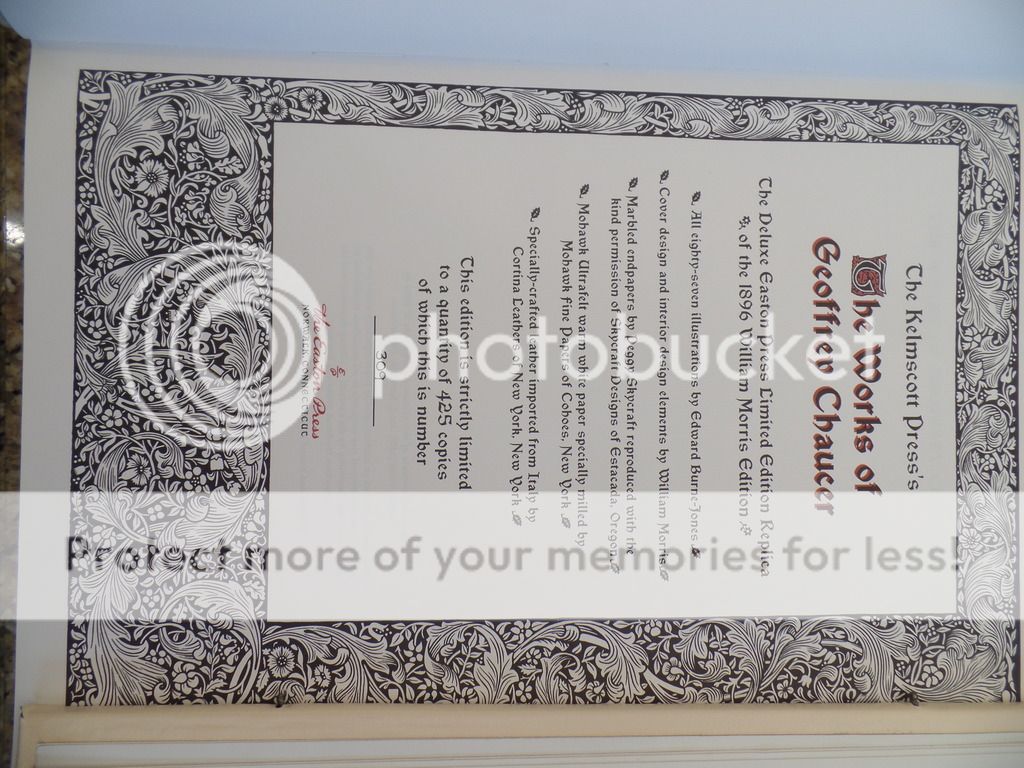

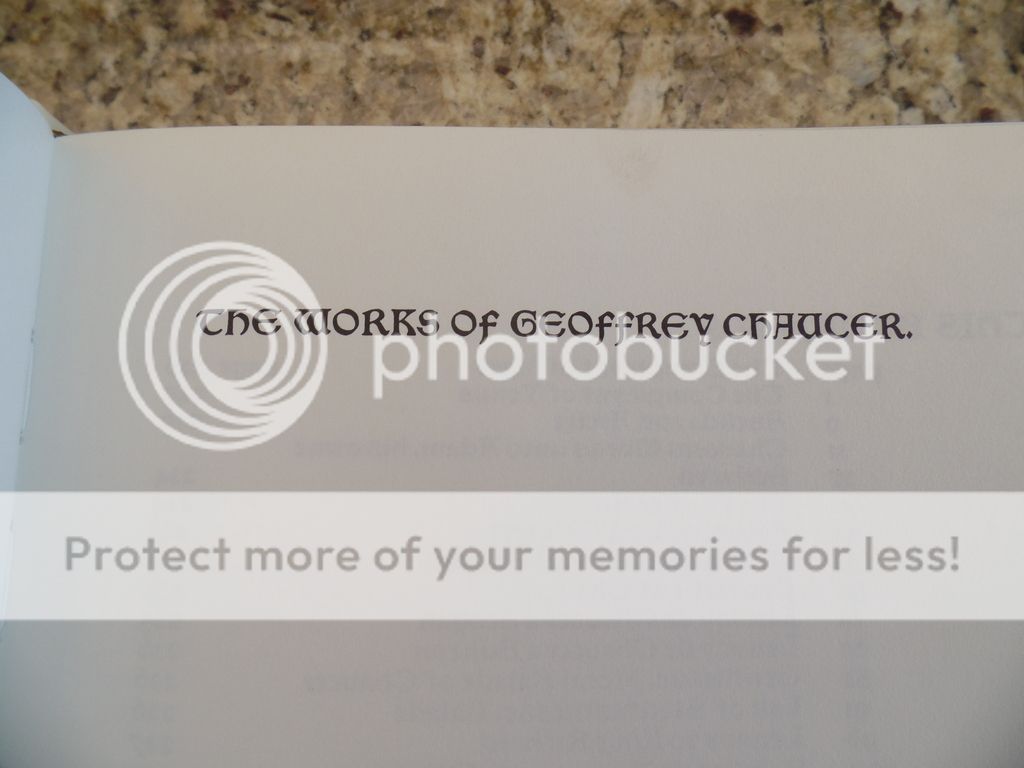
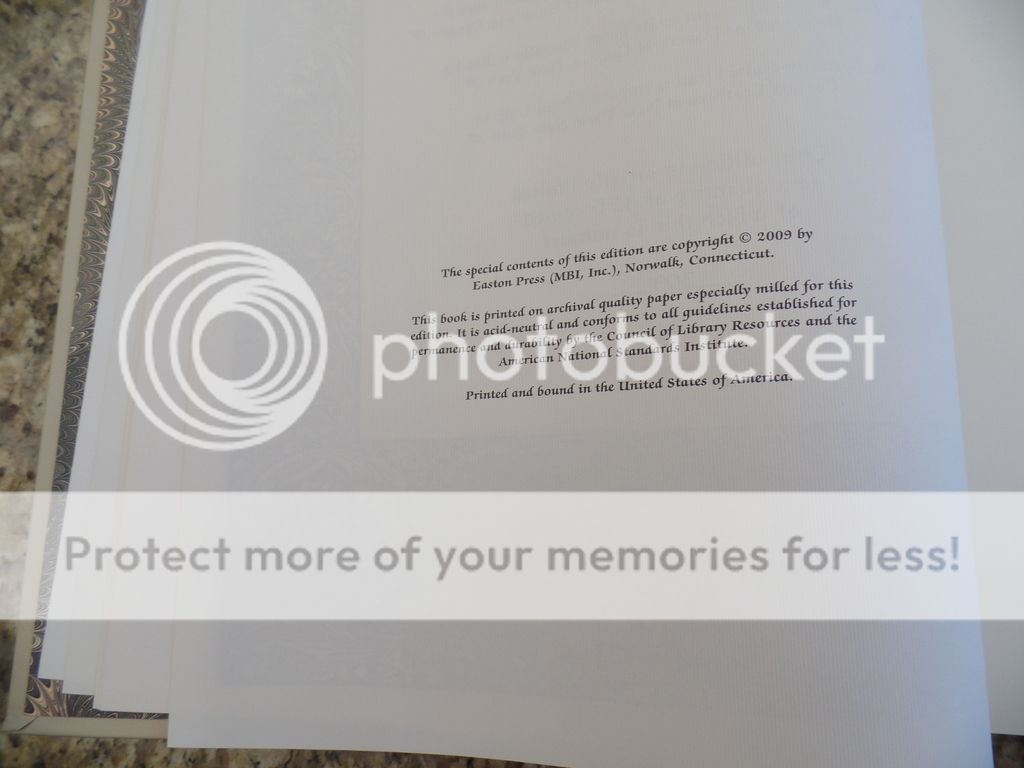
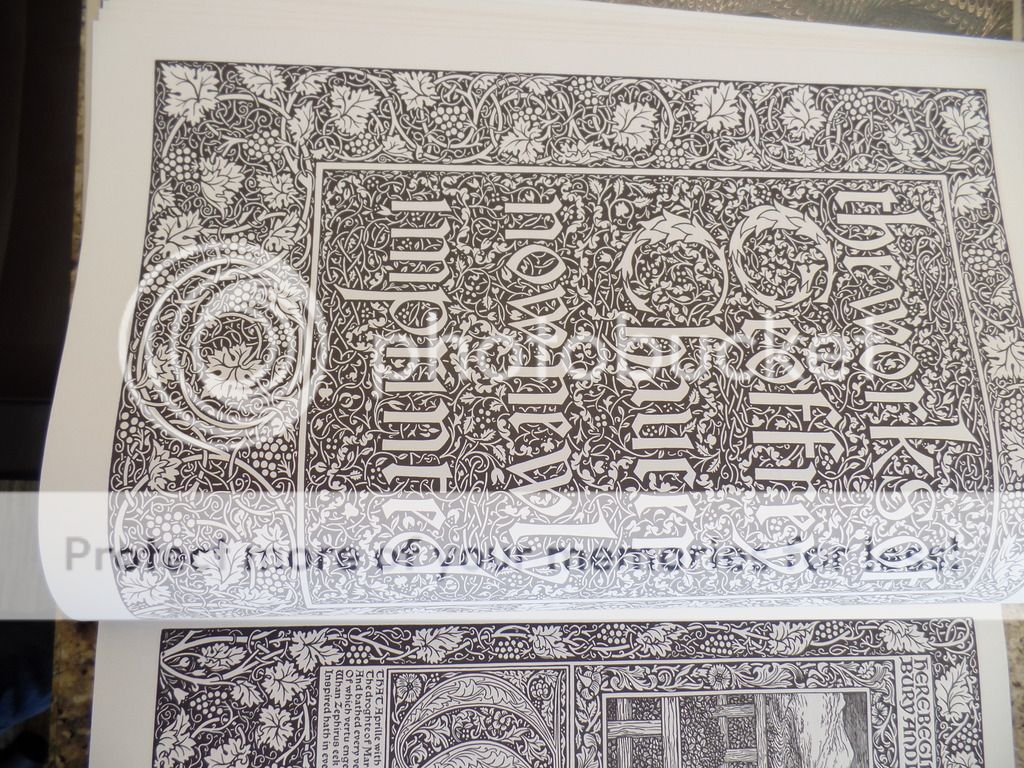
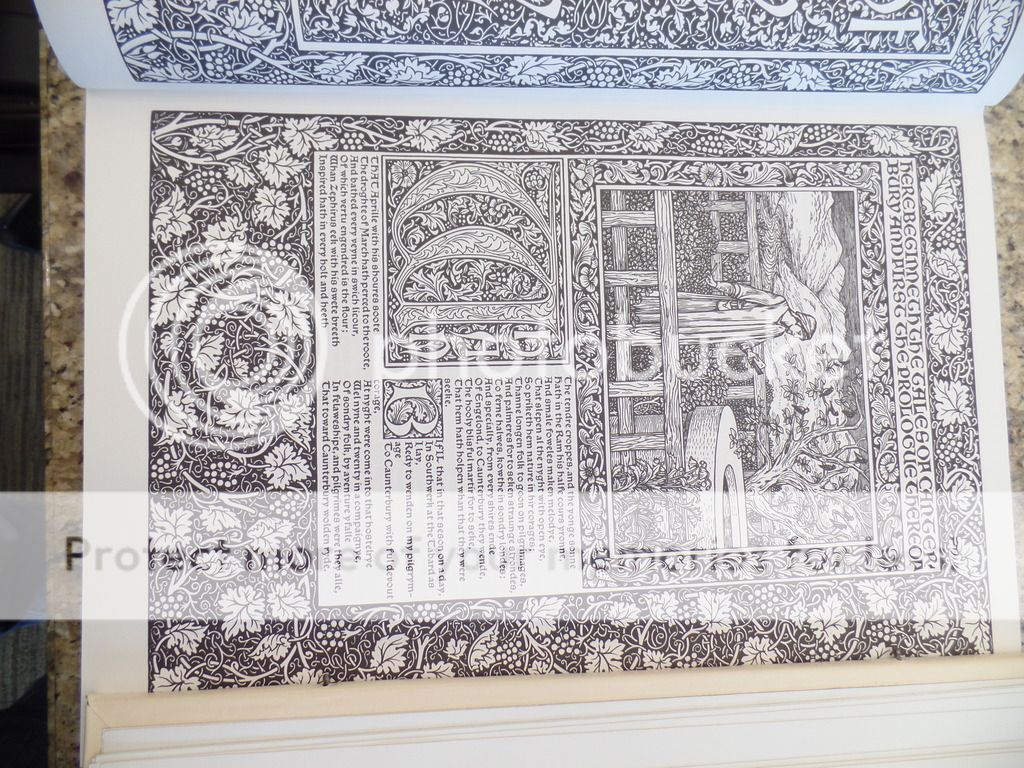
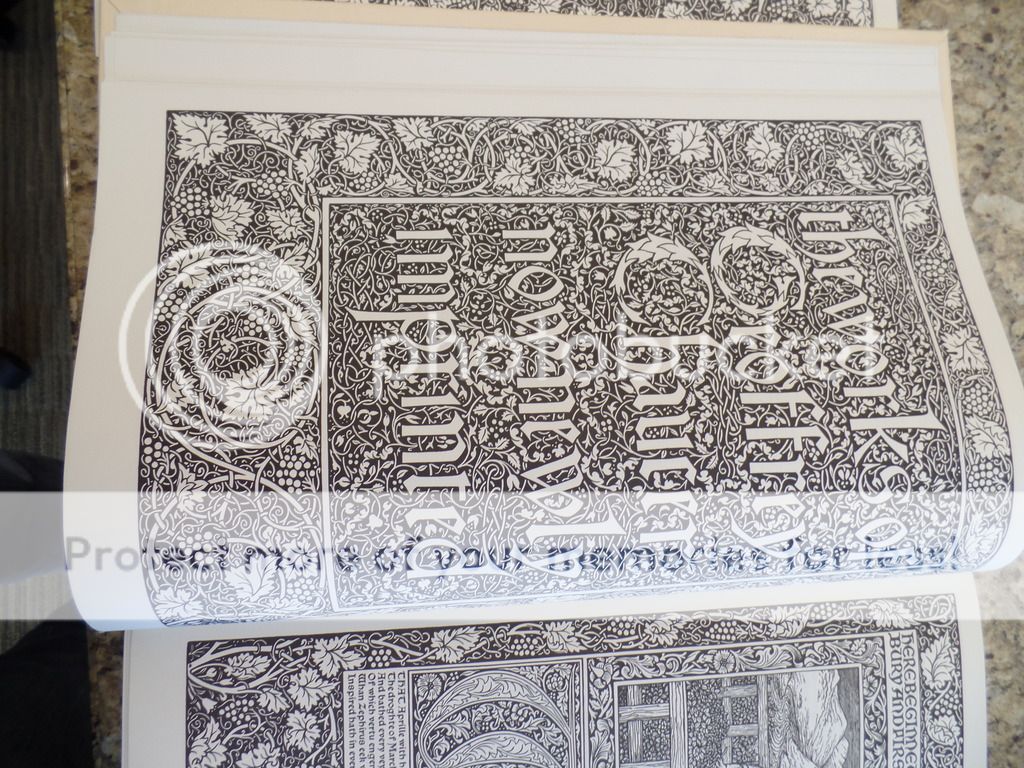
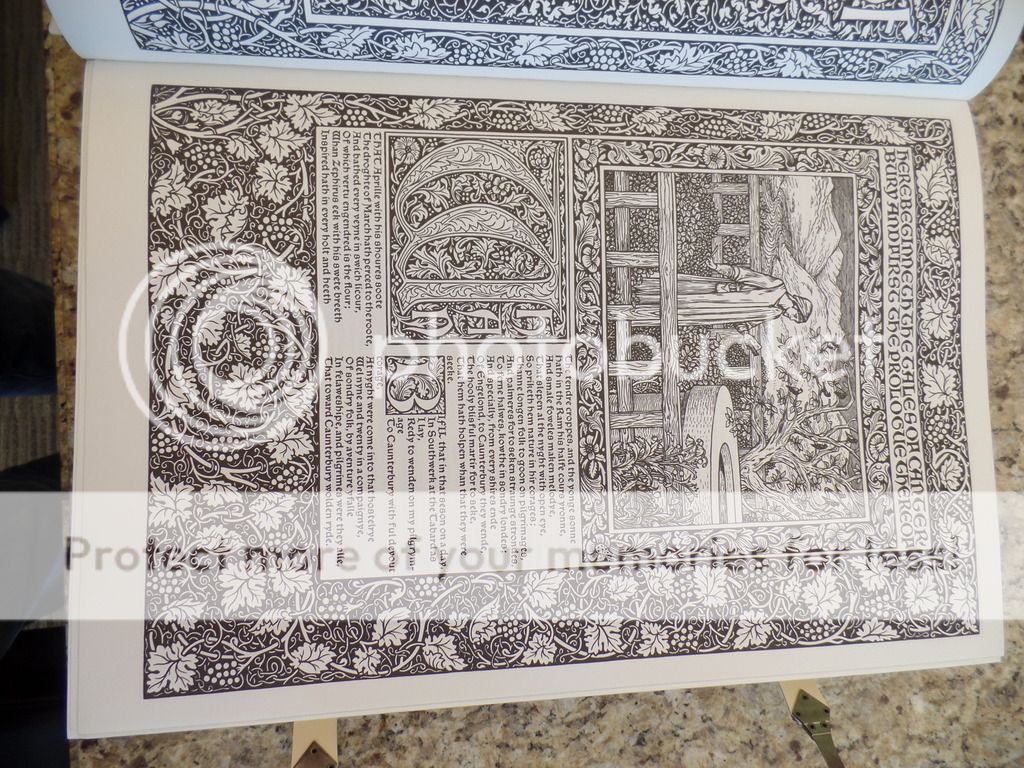
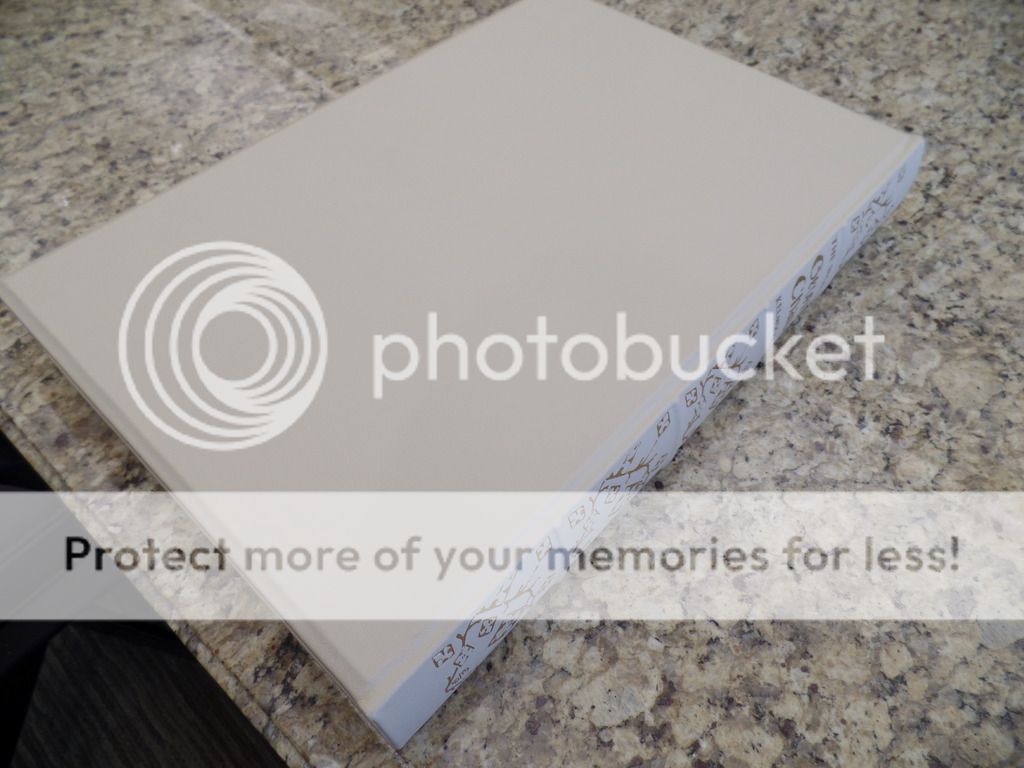
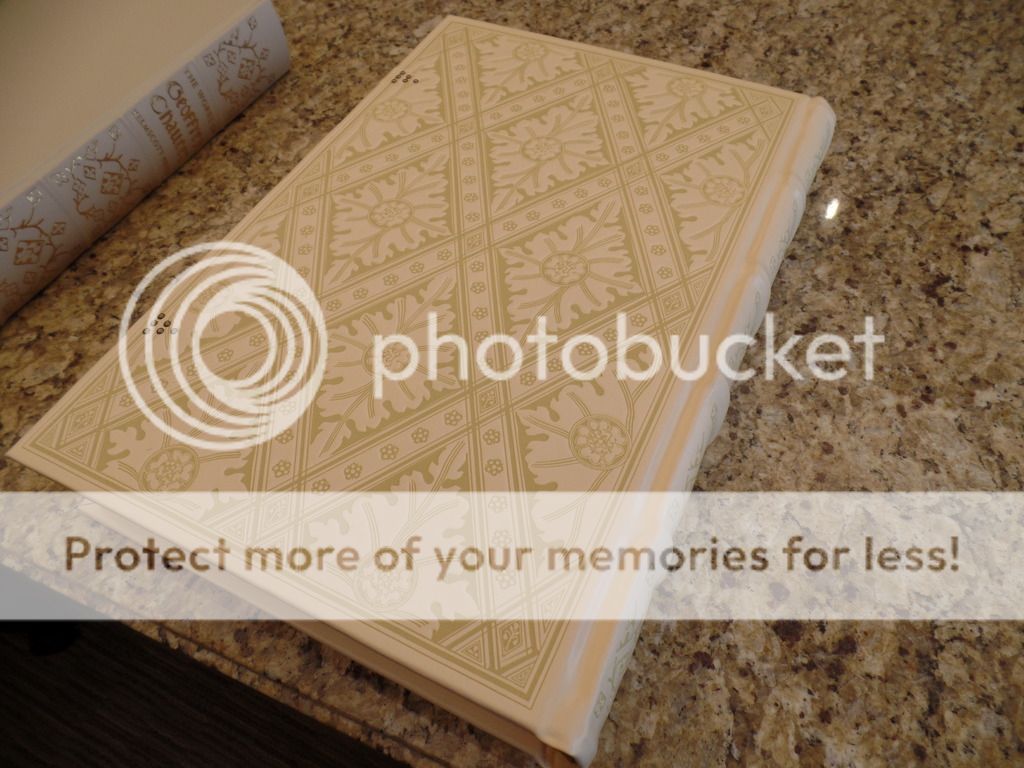
I took both into my place of work since my house is overrun with both Christmas decorations and family, and since this gave me a larger space to compare them. Below are some photo comparisons between Easton Press' edition, on the left when both are shown, and Bradford Exchange's version shown on the right.
I’ve included some general thoughts and observations. I am no book binding expert, so specific terms may have eluded me, and my photography skills are very rough, but hopefully this gives you some idea.
First, a note on the print run. Easton Press kept their print run true to the original Kelmscott run of 425. EP also randomizes editions sent to customers so you never know if you will get a low number, a high number, or somewhere in between. Bradford Exchange on the other hand decided on a much larger print run of 1896, deciding to honor the year that the Kelmscott Chaucer was released, and most likely try to maximize their profits in the long term. Judging from my low print run number, and the fact that I pre-ordered my book when I first heard about it, my assumption is that they are shipping these sequentially and that you are probably going to get a lower number if you order early. The price on both are almost exactly the same at $600, although of course EP’s book is no longer available and you will pay much more on the secondary market.
These books are both large and heavy. Easton’s is the heavier of the two at 12 lbs., 15.2 oz. (5.841kg), not including the clamshell box. Bradford comes in at 12 lbs., 0.2 oz. (5.443kg). I think this is by and large due to the paper, where Easton uses a denser product. I didn’t take the time to actually measure the dimensions of each book, but both are slightly larger than 11 ½ by 17 inches, and the Bradford book is slightly larger and a bit thicker than its Easton counterpart.
The paper on each is very different. EP uses a very textured product with a definite vertical grain across the page. I can’t be sure, as I am not a paper expert, but I believe that EP uses a heavy linen paper (someone please feel free to correct me on this point). The Bradford book uses a nice thick and heavy paper, but it doesn’t feel as luxurious as the EP product. You can also see that EP shears the fore edge of all of their pages flush and then gilts the edges to seal the book. On the BE book, the pages are rough cut and gilt before binding, which give it that rough cut look on each of the edges. I like each, but each simply takes a different approach. I am not sure what was done with the original Kelmscott books, but as I know most were covered after they left the Kelmscott Press, this will probably also vary widely depending on what the end customer decided to do.
The covers are both nice. You can obviously see that the colors are very different. The BE book is more of a white cream, whereas EP takes a slightly beige with a bit of olive in their leather dye color. The feel of the leather in both is very nice, both feeling about the same.
The stamping on each was a little different. EP has a slightly deeper stamping, and of course uses their normal gold gilt inlay to highlight the detail. The BE book uses an olive colored stamping that almost looks like a wash to bring the detail to life. Some of the stamping depth may have to do with the fact that BE uses wood in their cover, while EP uses a very thick cardboard (one of their thicker DLE covers). I of course haven’t taken the books apart to investigate further.
If you look at the cover detail closely, you will see that each has slightly different detail included in their stamping: EP has a little more details in items like the central grid, while BE has more detail in some of the floral wisps and some of the capital letters. Again, I am not sure which books that they emulated, but the differences might lie there. Also, the BE book had art on the back of the book, whereas the EP back cover is completely plain. I thought that was a very nice addition to the BE book. At first I wondered if Bradford had based their book off of Easton’s edition, but after comparing the details of the two and the slight size difference, this is not the case.
One thing I did note about the BE book, is that the cover color stamping is slightly off register in places which gives a “blurred” effect. This is only very slightly noticeable on some areas on the cover, but there is one of the panels on the spine, the fourth down, that this was quite pronounced. It was obvious that each of these panels was individually stamped or otherwise the entire spine would have been impacted. I have an up close photo of this section.
The leather work itself seemed to be a little more roughly completed on the BE edition. Whereas EP’s book has nice tight joints and corners and the seams were flat, BE’s book had some rougher bends and just appeared a little sloppier. I’ve included an up close photo on one of the worst of the interior corners of the BE book.
The actual binding itself also caught my attention on the Bradford book. The smyth sewn pages were good, I didn’t have any problem with the work there. As mentioned above this gave the pages that rough offset look that I actually like on many books. However, the leather joints that transition the cover to the spine at the top and bottom of the book didn’t bend in the same fashion, which gave each joints a different look and it didn’t look uniform as Easton’s normally always do. Also, the case liner on the interior back of the leather for the spine is not attached to the interior page liner on the page spine. If you press the spine leather, you can feel that there is glue between the two components, but it will slowly pop off again in a few moments. I don’t think this was necessarily a defect, due to the size of the book, the spine is allowed to flex as you open various sections throughout the book, I simply wasn't sure why there was glue between the two spine liners.
One thing that I do really like with the Bradford Exchange book is the clasps that help keep the book tightly bound. The hardware is very tastefully done, and the attachment points are very skillfully finished. You will note from the back cover that there are a cluster of rivets (screws/bolts?) that nicely hold the leather bands to the rear cover. The front cover simply has two small exposed beads that extend from the leather to which the clasp attaches. I can only guess that this bead attaches internally to the cover wood board, but couldn't feel any of the internal hardware, so that was nicely done as well.
Internally, the book printing is almost exactly the same. The EP edition has marbled end pages as pictured, the BE book has the same paper as end sheets as used in the rest of the book. The EP book does have an EP colophon page that points out the Easton specifics. There is no such BE colophon page in the BE book; any Bradford specific information is contained in the loose leaf data, edition and welcome letter contained as inserts. I have attached photos of each. I have not included many photos of the interior pages as printing from both books was very high quality with no discernible issue with either. However, I do humorously note that my edition of the Bradford book contains a few small fingerprint smudges on a couple of the interior pages at the beginning of the book, but this isn’t an issue for me.
The Easton Press Kelmscott of course comes with a large green clamshell box with a matching green ribbon to help lift it from the box. The Bradford Exchange book simply stands alone, no box or cover. The EP book also has the standard EP ribbon book mark, while BE doesn’t include a ribbon.
Overall, I do like the Bradford Exchange book. Yes, I think there are some quality issues which don’t make it a nice as the Easton Press book. However, I do think that Bradford has some very nice aspects that I really appreciated: the clasps, back cover art, cover shading (vs. gold gilt) and the rough cut fore edges of the paper. If you don’t have the Easton Press Chaucer, this might be a good opportunity to pick up an alternative. Will the Bradford book impact the secondary market prices of the EP book? Time will only tell, but the two are clearly different so EP purists may still want the EP version. Also, the larger print run of the Bradford edition will probably help to keep its values a bit lower. Again, I don’t really buy for investment as I do for enjoyment of the book. I haven’t decided if I will keep the Bradford edition.
Hopefully I haven’t droned on too much. Enjoy the photos.
























2HugoDumas
>1 hamletscamaro: Remarkable analysis. Thank you. Are you keeping both?
3hamletscamaro
>HugoDumas, I haven't decided if I am keeping both. It is not an insignificant chunk of change for something that I already have. However, it is the perfect size to keep dust off of the top of my EP Kelmscott clam shell case!
Also, SilentInAWay posted some additional photos originally of EPs version, and I meant to include those here as well. Here is the link to that thread:
http://www.librarything.com/topic/76834
Also, SilentInAWay posted some additional photos originally of EPs version, and I meant to include those here as well. Here is the link to that thread:
http://www.librarything.com/topic/76834
4astropi
3: "However, it is the perfect size to keep dust off of the top of my EP Kelmscott clam shell case!"
:D very funny!
First, thanks for that thorough and excellent comparison. Secondly, in my opinion there's no comparison. If the BE edition had been an EP DLE I guarantee you members would be up in arms over the quality. That said, this is the Bradford Exchange and unfortunately it is made in China. I think it's a lost opportunity. I really really wish BE had decided to publish this in the USA. I believe it could have been similar to the EP version in terms of quality. Ah well. Ultimately though, the important thing is whether you are happy with it? Myself, I definitely have no interest in this book after seeing the EP and BE side-by-side.
:D very funny!
First, thanks for that thorough and excellent comparison. Secondly, in my opinion there's no comparison. If the BE edition had been an EP DLE I guarantee you members would be up in arms over the quality. That said, this is the Bradford Exchange and unfortunately it is made in China. I think it's a lost opportunity. I really really wish BE had decided to publish this in the USA. I believe it could have been similar to the EP version in terms of quality. Ah well. Ultimately though, the important thing is whether you are happy with it? Myself, I definitely have no interest in this book after seeing the EP and BE side-by-side.
5EastonQuality
Wanted to see pictures from their website, they never posted the book nor received any advertising. Beautifully done binding.
6cu29640
Thank you for the excellent review and detailed pics. Thats what makes this forum outstanding. I try to add good pics of my purchases as well. Certainly none of the marketers ever show true detailed pics. The only thing from the pics that bothers me is the doubled up end page. But the binding has a character that makes it look more hand-bound than EP. The EP one is certainly nice and the made in TN is a big plus. Though for Bradford's first ever higher end leather book...not bad. Easton has been doing it since 1973. I am thinking on the BE version but would have been happy with the EP version if I had been able to buy it new from EP. On the BE registration issue in the binding...looks like they emboss...then print the color in two steps. Maybe after the first run they will correct stuff. 365 day return maybe you will want to switch it out at some point haha.
7WilliamPilgrim
Thanks Hamlet for the time to share your images and thoughts !! I have yet to open mine... the hunt is always more exciting
8cu29640
I do like the nice thick edge stitching detail (forgot technical term) on the BE version. The spine issue...are you referring to the void that appears when you open the book between the inside of the leather spine and the back of the page block? I have always seen this as open space or the book would not open. There is often a rubbery glue on the back of the page block. Maybe we are thinking about two different things though.
9katielouise
This is nicer than I thought it would be. I like the cover of the BE one significantly more than the EP.
10Studedoo
Thanks for the extensive write-up. The EP is obviously much less sloppily finished (and I don't think this is any surprise, given the Chinese production), but IMHO the BE version is a much better aesthetic design (principally less gaudy thanks to eliminating the gilt stamping and page edges). A hybrid of the best features of the two would be a fantastic product. The EP seems to be much more precisely constructed, whereas pretty much everything on the BE is just a little-bit off, from the slightly out-of-whack alignment of the top vs bottom components of the clasp to the corners or the ends of the spine.
I'm not financially in the market for either, but I don't think I could shell out for the BE given the lack of precision in the implementation. That said, it isn't bad, just not sure it is $600-worth, and I'm not sure how much I would trust Chinese-sourced adhesives to go the distance. I don't think these will sell out quickly, and I wouldn't be at all surprised to see them discounted.
I'm not financially in the market for either, but I don't think I could shell out for the BE given the lack of precision in the implementation. That said, it isn't bad, just not sure it is $600-worth, and I'm not sure how much I would trust Chinese-sourced adhesives to go the distance. I don't think these will sell out quickly, and I wouldn't be at all surprised to see them discounted.
11JustinTChan
>10 Studedoo:
I won't go too far into it, but you are comparing Chinese production against functionally non-existent American production.
Along those same lines, I suppose we could laud the humanity of Texas platinum mining operations against South Africa's blood-platinum. Except that there are no platinum mines in Texas. :)
I won't go too far into it, but you are comparing Chinese production against functionally non-existent American production.
Along those same lines, I suppose we could laud the humanity of Texas platinum mining operations against South Africa's blood-platinum. Except that there are no platinum mines in Texas. :)
12Studedoo
>11 JustinTChan:
"Functionally non-existent American production".
You mean like the functionally non-existent American production that EP happily uses? Or the production capability all over the world, in fact, that just happens to be not quite as cheap as China. EP has a well-produced, American manufactured volume, only let down (IMHO) by sticking too rigidly to their design-ethic (which is getting a little dated).
(By the way, I'm not sure that there is such a thing as "blood-platinum" in South Africa. Other than illegal mining, mining is fairly heavily unionised and much of it is now unprofitable, due to large annual wage and power-cost increases, coupled with labour-force resistance to mechanisation. Disclaimer: I worked for a South African gold miner for 10 years. But anyway, post-apartheid SA politics, etc, is a bit OT, and your point is moot as you are claiming a capability ("printing/binding") does not exist in America, when it patently does).
"Functionally non-existent American production".
You mean like the functionally non-existent American production that EP happily uses? Or the production capability all over the world, in fact, that just happens to be not quite as cheap as China. EP has a well-produced, American manufactured volume, only let down (IMHO) by sticking too rigidly to their design-ethic (which is getting a little dated).
(By the way, I'm not sure that there is such a thing as "blood-platinum" in South Africa. Other than illegal mining, mining is fairly heavily unionised and much of it is now unprofitable, due to large annual wage and power-cost increases, coupled with labour-force resistance to mechanisation. Disclaimer: I worked for a South African gold miner for 10 years. But anyway, post-apartheid SA politics, etc, is a bit OT, and your point is moot as you are claiming a capability ("printing/binding") does not exist in America, when it patently does).
13astropi
11: "you are comparing Chinese production against functionally non-existent American production."
I'm not sure what you're saying? Easton Press books are printed and bound in the USA, so where are the issues in comparison?
I'm not sure what you're saying? Easton Press books are printed and bound in the USA, so where are the issues in comparison?
14hamletscamaro
>astropi, Yes, I agree that if EP put out a volume with some “beginner” mistakes such as this volume, they would be torn apart in forum comments.
>cu29640, I agree, the cover does look embossed, and most likely follow up with a second printing process for the ink on the cover. I expect volume 1720 will look much better than volume 72. So perhaps waiting on this volume may be wise. It will be interesting to see how well this does for them as they have a much larger customer list than EP, but how many will be interested in books vs. “designer resin” cuckoo clocks? Time will only tell.
For the gap in the spine, the gap exists whether the book is open or closed. I think if they did intend to glue this portion, it would simply fit oddly in any case. So I think the gap is fine, just unsure as to the existence of the glue.
>WilliamPilgrim, we look forward to you throwing your opinion once you unbox your volume. I’m not sure how you can resist opening the box just to see what you get.
>JustinTChan, actually, I live in Texas. I see gold diggers very often when I go to malls, so I imagine that platinum diggers have to be laced in there as well. I don’t think I laud their actions.
>cu29640, I agree, the cover does look embossed, and most likely follow up with a second printing process for the ink on the cover. I expect volume 1720 will look much better than volume 72. So perhaps waiting on this volume may be wise. It will be interesting to see how well this does for them as they have a much larger customer list than EP, but how many will be interested in books vs. “designer resin” cuckoo clocks? Time will only tell.
For the gap in the spine, the gap exists whether the book is open or closed. I think if they did intend to glue this portion, it would simply fit oddly in any case. So I think the gap is fine, just unsure as to the existence of the glue.
>WilliamPilgrim, we look forward to you throwing your opinion once you unbox your volume. I’m not sure how you can resist opening the box just to see what you get.
>JustinTChan, actually, I live in Texas. I see gold diggers very often when I go to malls, so I imagine that platinum diggers have to be laced in there as well. I don’t think I laud their actions.
15astropi
14: OT but interestingly enough people still prospect for gold in various parts of the country. I wonder if they do it as recreation or do they really hope to strike it rich??
16Studedoo
>15 astropi:
There is still money to be made in Gold, so long as extraction can be done economically (there is quite a bit of gold in the world, but getting it out has become increasingly difficult and expensive as the easy stuff has generally been mined). I think for most individuals prospecting in first world countries, it tends to be for alluvial gold and is a hobby that returns a bit of money. We have quite a lot of gold panners around here, some of whom definitely do make money (especially those with a bit of equipment, including sluices, etc), but probably not much of a return on the hours spent on the task, if it was being done solely for economic reasons. Commercial production usually requires explosives, crushers and lots of cyanide, so it tends to be a non-starter for the average joe, plus all the obvious areas have been mined out.
There is still money to be made in Gold, so long as extraction can be done economically (there is quite a bit of gold in the world, but getting it out has become increasingly difficult and expensive as the easy stuff has generally been mined). I think for most individuals prospecting in first world countries, it tends to be for alluvial gold and is a hobby that returns a bit of money. We have quite a lot of gold panners around here, some of whom definitely do make money (especially those with a bit of equipment, including sluices, etc), but probably not much of a return on the hours spent on the task, if it was being done solely for economic reasons. Commercial production usually requires explosives, crushers and lots of cyanide, so it tends to be a non-starter for the average joe, plus all the obvious areas have been mined out.
17WilliamPilgrim
Sorry Folks, I'm getting closer... I opened the Box and held the Bradford; but I did not undo the sealed plastic protection wrapper.
The over all look is very nice. The designs on "my" Spine were all in registration; and overall very beautiful. But as they say "the devil in the details" — or God is in the details if you prefer. My Thought at this moment is this : If this Book were done by an American or British Bookbinder, and contained no flaws (in other words : perfection) The Cost would be $3000. give or take.
So at $600. with an edition of 1896, more of us will have a chance to buy, and at a more affordable price. — The only thought that I was alarmed by was that one of you pointed out that there's a chance the "Chinese" glue may not stand the test of time— Are we to believe that the Glue used is an american product, (applied by Chinese workers).... With a 365 Day Return policy, I am less concerned.
I'll get back as soon as I open the sealed plastic. I promise.
— the "hunt" is more enjoyable than the "kill". —
The over all look is very nice. The designs on "my" Spine were all in registration; and overall very beautiful. But as they say "the devil in the details" — or God is in the details if you prefer. My Thought at this moment is this : If this Book were done by an American or British Bookbinder, and contained no flaws (in other words : perfection) The Cost would be $3000. give or take.
So at $600. with an edition of 1896, more of us will have a chance to buy, and at a more affordable price. — The only thought that I was alarmed by was that one of you pointed out that there's a chance the "Chinese" glue may not stand the test of time— Are we to believe that the Glue used is an american product, (applied by Chinese workers).... With a 365 Day Return policy, I am less concerned.
I'll get back as soon as I open the sealed plastic. I promise.
— the "hunt" is more enjoyable than the "kill". —
18astropi
17: "If this Book were done by an American or British Bookbinder, and contained no flaws (in other words : perfection) The Cost would be $3000. give or take."
The EP Kelmscott was $594. That included a clamshell case. How did you come up with $3000? Sorry, I don't agree. While I don't own the book, considering the comparisons that hamlet made, I believe if it was made by an American binder it would cost around $500, give or take.
The EP Kelmscott was $594. That included a clamshell case. How did you come up with $3000? Sorry, I don't agree. While I don't own the book, considering the comparisons that hamlet made, I believe if it was made by an American binder it would cost around $500, give or take.
19WilliamPilgrim
The EP now goes for 1,200+ on the secondary market.
The 1975 Kelmscott Chaucer by the UK Basilick Press goes for 2,800 + on the secondary market.
The FS editions are also marked up sharply on the secondary market, or at least the Leather Version is.
I see your point, and perhaps failed to make mine :
— if the BP was made in the US with high craftsmanship... it would sell fast, and the secondary market would take over
as soon as it were sold out.
The 1975 Kelmscott Chaucer by the UK Basilick Press goes for 2,800 + on the secondary market.
The FS editions are also marked up sharply on the secondary market, or at least the Leather Version is.
I see your point, and perhaps failed to make mine :
— if the BP was made in the US with high craftsmanship... it would sell fast, and the secondary market would take over
as soon as it were sold out.
20astropi
19: OK, with that I can agree :) Although I don't think it would be near $3000. Not when there are over 1800 copies. The EP edition only had 425.
21WilliamPilgrim
I retract my theory as posted. I have seen the light.
22JuliusC
>1 hamletscamaro: Thank you your pics are a good representation of the books. Looks better than what's on the website.
23Studedoo
>19 WilliamPilgrim:
I see your point, and perhaps failed to make mine : — if the BP was made in the US with high craftsmanship... it would sell fast, and the secondary market would take over as soon as it were sold out.
That's a very different point than the one you originally posted! I initially saw the $3000 comment and laughed :) I think comparing new prices to speculative secondary market prices is a bit of a non-starter as one can pull any numbers out of thin air for that. Plus, the more variants of this same book that are printed, the less exclusive any of the existing versions are. There will be a point that the market is saturated. These aren't going to sell for $3000, ever.
Now get that shrinkwrap off it, so we can see if the previously described flaws are present on each copy or if there is a bit of variance! :)
I see your point, and perhaps failed to make mine : — if the BP was made in the US with high craftsmanship... it would sell fast, and the secondary market would take over as soon as it were sold out.
That's a very different point than the one you originally posted! I initially saw the $3000 comment and laughed :) I think comparing new prices to speculative secondary market prices is a bit of a non-starter as one can pull any numbers out of thin air for that. Plus, the more variants of this same book that are printed, the less exclusive any of the existing versions are. There will be a point that the market is saturated. These aren't going to sell for $3000, ever.
Now get that shrinkwrap off it, so we can see if the previously described flaws are present on each copy or if there is a bit of variance! :)
24cu29640
The edition size shouldn't really affect the cost. Remember economics...at a higher price suppliers are willing to supply more. I know we want to think that if they have a larger number they can spread the costs out...but all the details we ask for would still be on each and every book despite how many are produced. Plus if a company can sell less for more..they will....so they try to sell more for more. Maybe Bradford will learn and adapt. They are really into that China manufacturing though. For ceramics its perfect. They tried coins there too..unless you get the China Government Mint to make the coins then they look like a kindergarten class made them.
25astropi
24: "The edition size shouldn't really affect the cost."
Basic supply and demand. If EP only printed 10 copies of the Kelmscott do you think you could find a copy for $1500? I imagine it would be closer to $10,000. Maybe significantly more. For something such as these books, a niche market, there is a very small demand to begin with. If the market is saturated price will go down. So edition size makes a huge difference. This is one reason why the wonderful LEC books can be purchased at very low prices. Many were printed in editions of 1500-2000 copies.
Basic supply and demand. If EP only printed 10 copies of the Kelmscott do you think you could find a copy for $1500? I imagine it would be closer to $10,000. Maybe significantly more. For something such as these books, a niche market, there is a very small demand to begin with. If the market is saturated price will go down. So edition size makes a huge difference. This is one reason why the wonderful LEC books can be purchased at very low prices. Many were printed in editions of 1500-2000 copies.
26cu29640
Yes you are referring to secondary market prices due to rarity. True there but the retailer technically wants to maximize profit..they would rather see the profit than have that margin realized on the secondary market. I know that as a fact from MBI and Bradford. Plus you have to collect because you like it...if it ends up being sought after then that's just a plus. But the mass market has killed many quality collectibles simply due to speculation causing over production.
I am just glad we have choices for nice books...I do prefer the USA made EP volumes and the European cottage industry printed Folio LEs. But glad to see a third marketer trying books. We are lucky. The average member of the public barely knows what a book is...they definitely do not know who Chaucer is.
I am just glad we have choices for nice books...I do prefer the USA made EP volumes and the European cottage industry printed Folio LEs. But glad to see a third marketer trying books. We are lucky. The average member of the public barely knows what a book is...they definitely do not know who Chaucer is.
27Studedoo
>25 astropi:
I'd agree, there is obviously a certain amount of fixed costs associated with tooling and general set up (including admin, design work, etc), and the fewer copies that the general costs can be spread across, the higher the unit cost. Similarly, beyond a certain number of units, the unit cost is unlikely to fall for each extra unit (as there are no savings to be made). For small production runs, unit costs are always going to be higher, and potentially significantly so. I guess what counts as "small" will very much depend on the individual product/project, but I'd guess a run of anything less than a couple of hundred books would end up carrying a premium in terms of production cost (and is likely why 250 copies is usually the lower-bound for limited editions from most publishers).
I disagree with the idea that if EP printed 10 copies of a book, it would be $10,000 or more. It is more likely that above a certain value (much lower than that), there would simply be no buyers. The books would sell to no one as the demand would be zero. EP isn't well enough regarded to push product at that kind of price (and this is no snub to EP - I don't suppose there are many publishers that are).
I'd agree, there is obviously a certain amount of fixed costs associated with tooling and general set up (including admin, design work, etc), and the fewer copies that the general costs can be spread across, the higher the unit cost. Similarly, beyond a certain number of units, the unit cost is unlikely to fall for each extra unit (as there are no savings to be made). For small production runs, unit costs are always going to be higher, and potentially significantly so. I guess what counts as "small" will very much depend on the individual product/project, but I'd guess a run of anything less than a couple of hundred books would end up carrying a premium in terms of production cost (and is likely why 250 copies is usually the lower-bound for limited editions from most publishers).
I disagree with the idea that if EP printed 10 copies of a book, it would be $10,000 or more. It is more likely that above a certain value (much lower than that), there would simply be no buyers. The books would sell to no one as the demand would be zero. EP isn't well enough regarded to push product at that kind of price (and this is no snub to EP - I don't suppose there are many publishers that are).
28WilliamPilgrim
Ok Folks I have to add there is a "High End" for Facsimiles
And buyers ! Here are a few below. Over 10K ! : )
http://www.biblio.com/book/rothschild-miscellany-fine-facsimile-edition-illumina...
http://www.newbostonfineandrarebooks.com/?page=shop/flypage&product_id=11300...
http://www.biblio.com/book/visigothic-mozarabic-bible-st-isidore-fine/d/61093799...
And buyers ! Here are a few below. Over 10K ! : )
http://www.biblio.com/book/rothschild-miscellany-fine-facsimile-edition-illumina...
http://www.newbostonfineandrarebooks.com/?page=shop/flypage&product_id=11300...
http://www.biblio.com/book/visigothic-mozarabic-bible-st-isidore-fine/d/61093799...
29Wootle
28-- Those are asking prices, and that seller is known as one that does huge mark ups, and probably doesn't sell much.
30WilliamPilgrim
http://www.abebooks.com/rare-books/most-expensive-sales/year-2014.shtml
see # 19 and # 20
sorry but these do sell.
see # 19 and # 20
sorry but these do sell.
31mortalalliance
>28 WilliamPilgrim:
>30 WilliamPilgrim:
Even with the existence of high end facsimile sales, a less then perfect facsimile made in China and produced by a company which, heretofore, has never produced high end facsimiles and is best known for sales of knick-knacks and dubious collectibles is not going to fetch anything remotely close to your claims.
>30 WilliamPilgrim:
Even with the existence of high end facsimile sales, a less then perfect facsimile made in China and produced by a company which, heretofore, has never produced high end facsimiles and is best known for sales of knick-knacks and dubious collectibles is not going to fetch anything remotely close to your claims.
32WilliamPilgrim
I agree with you there —
I need to revise, or re-construct my statement : IF the BE Chaucer were made in the US by a Crafted-bookbinder with a lower edition number and the best materials : the appeal would drive the secondary market much, much more than the asking price.
I need to revise, or re-construct my statement : IF the BE Chaucer were made in the US by a Crafted-bookbinder with a lower edition number and the best materials : the appeal would drive the secondary market much, much more than the asking price.
33Studedoo
>32 WilliamPilgrim:
I agree with you there —
I need to revise, or re-construct my statement : IF the BE Chaucer were made in the US by a Crafted-bookbinder with a lower edition number and the best materials : the appeal would drive the secondary market much, much more than the asking price.
No, it *MIGHT* obtain much more on the secondary market. There *MIGHT* be the odd actual sale at two or three times the initial asking price for a few years whilst few of them have yet filtered back onto the market. But all this is moot, as the book is made in China and - if the example we have seen so far is anything to go by - to a relatively mediocre standard. And we don't yet know what your copy looks like as we are told it is still in shrink-wrap (those on that other thread - who might be a bit paranoid - that were crying "shill" (with no evidence other than when your account was created and the posting history) might be thinking you are awaiting a better copy to put up pictures of !!...).
>30 WilliamPilgrim:
I actually think that list is a perfect example of how most of the expensive books listed on Abe don't actually sell. I see books listed in the many thousands of dollars all the time, yet the top 50 list is already down below $10,000 by the time we get to number 39.
I must admit I do object when these forums get into "Buy X because it will probably be worth Y in a few years" territory. Books are generally a terrible investment (which may go up or down -- statistically more often down).
I agree with you there —
I need to revise, or re-construct my statement : IF the BE Chaucer were made in the US by a Crafted-bookbinder with a lower edition number and the best materials : the appeal would drive the secondary market much, much more than the asking price.
No, it *MIGHT* obtain much more on the secondary market. There *MIGHT* be the odd actual sale at two or three times the initial asking price for a few years whilst few of them have yet filtered back onto the market. But all this is moot, as the book is made in China and - if the example we have seen so far is anything to go by - to a relatively mediocre standard. And we don't yet know what your copy looks like as we are told it is still in shrink-wrap (those on that other thread - who might be a bit paranoid - that were crying "shill" (with no evidence other than when your account was created and the posting history) might be thinking you are awaiting a better copy to put up pictures of !!...).
>30 WilliamPilgrim:
I actually think that list is a perfect example of how most of the expensive books listed on Abe don't actually sell. I see books listed in the many thousands of dollars all the time, yet the top 50 list is already down below $10,000 by the time we get to number 39.
I must admit I do object when these forums get into "Buy X because it will probably be worth Y in a few years" territory. Books are generally a terrible investment (which may go up or down -- statistically more often down).
34HugoDumas
I am not a Chaucer fan; simply do not have the verbal comprehension to fully appreciate this masterpiece. But after following this dialogue I would have chosen the EP version, with regrets they did not print on the back of the book. I am pretty much a HUGE fan of EP. Only have 5 DLEs and about 400 regular EPs with about 400 Franklins. Missing Franklin and wish they were in business since creative competition is good for us book collectors. Looking back I still think Franklin made some of the best leather books especially GBWW and the Oxford collection. These two companies have given me great joy in my life. And for this I am grateful.
35astropi
Very expensive facsimiles have been reproduced for years at thousands of dollars. I honestly do not know who collects these. I can only assume very very wealthy people. Why are there facsimiles of these books? I believe that most of these are a one-of-a-kind and therefore it's not like the Kelmscott which rare and expensive as it is, had 425 copies produced.
http://www.foliosociety.com/book/BBM/bible-moralisee
http://www.foliosociety.com/book/BBM/bible-moralisee
36cu29640
Yes Franklin Mint dba Franklin Library books were stunning. They did make cheaper volumes at cheaper prices but no different than Folio. Too bad their marketing went astray and they handed the market to EP and others (who copied Franklin to start with). FM sweated the details on every product they developed...even if the style may not have been someone's choice the R&D perfection was there.
37WilliamPilgrim
Well — I un-wrapped my Bradford Chaucer last night —
I get home late every night and often I don't have much time to relax — So my apologies (with my delay)
My Bradford is very much as described by Sir Hamlet : ( which is not great — the Clasps work great,
the Pages are very nice both type and art BUT : the Same Sloppy work on the front and back End-pappers have been pasted down with a large piece and a thin slice added to the top, as if they cut and measured incorrectly : (
But over all a Lovely Book ! — With that said — I am going to Ask for a replacement from the Bradford Press.
I will try to take pictures over the weekend and share before I mail back. If they can return a new copy # with no sloppy end-paper work I will keep. One of you mentioned that perhaps the low numbers of the 1,896 count will be less than perfect — as the Binder Team in China does better, or am I dreaming ? With a 365-day return policy I'm up to this !
Happy New Year All
I get home late every night and often I don't have much time to relax — So my apologies (with my delay)
My Bradford is very much as described by Sir Hamlet : ( which is not great — the Clasps work great,
the Pages are very nice both type and art BUT : the Same Sloppy work on the front and back End-pappers have been pasted down with a large piece and a thin slice added to the top, as if they cut and measured incorrectly : (
But over all a Lovely Book ! — With that said — I am going to Ask for a replacement from the Bradford Press.
I will try to take pictures over the weekend and share before I mail back. If they can return a new copy # with no sloppy end-paper work I will keep. One of you mentioned that perhaps the low numbers of the 1,896 count will be less than perfect — as the Binder Team in China does better, or am I dreaming ? With a 365-day return policy I'm up to this !
Happy New Year All
38Studedoo
>37 WilliamPilgrim:
One of you mentioned that perhaps the low numbers of the 1,896 count will be less than perfect — as the Binder Team in China does better, or am I dreaming ? With a 365-day return policy I'm up to this !
I guess it is possible, but it may well depend if the numbering correlates closely at all to the production sequence, and how many people are working on making them. If there are multiple workers and some are more skilled than others, the number on the book is unlikely to have any real value as an indicator of quality. I'd say it is more likely to be pot luck which specific set of defects you get, especially given the country of origin.
Return it, see if you get a better one. If you don't get a decent copy second time around, then save your money. The market will likely not see value in a sloppily made Chinese product produced by a knick-knack company (even if a percentage of copies are good enough to pass muster, they will be tainted by the "sloppy" copies), so if you think you will ever need to turn it back into money, this should be a consideration. I must admit, I can't personally see the point of having a "luxury item" where the workmanship isn't great, and the picture of that inner corner and end paper with the added strip looks horrible (contrasted to the EP, there is just no competition).
I really hope EP is reading this thread, as I'm sure they will at some point consider offshoring production, and it would be a terrible mistake (they have enough QC issues as is).
One of you mentioned that perhaps the low numbers of the 1,896 count will be less than perfect — as the Binder Team in China does better, or am I dreaming ? With a 365-day return policy I'm up to this !
I guess it is possible, but it may well depend if the numbering correlates closely at all to the production sequence, and how many people are working on making them. If there are multiple workers and some are more skilled than others, the number on the book is unlikely to have any real value as an indicator of quality. I'd say it is more likely to be pot luck which specific set of defects you get, especially given the country of origin.
Return it, see if you get a better one. If you don't get a decent copy second time around, then save your money. The market will likely not see value in a sloppily made Chinese product produced by a knick-knack company (even if a percentage of copies are good enough to pass muster, they will be tainted by the "sloppy" copies), so if you think you will ever need to turn it back into money, this should be a consideration. I must admit, I can't personally see the point of having a "luxury item" where the workmanship isn't great, and the picture of that inner corner and end paper with the added strip looks horrible (contrasted to the EP, there is just no competition).
I really hope EP is reading this thread, as I'm sure they will at some point consider offshoring production, and it would be a terrible mistake (they have enough QC issues as is).
39GOBOGIE
No affiliation but there is a copy of this (the Bradford exchange one) for sale on EBay currently. Not sure if they are OOP from Bradford by now or not?
40hamletscamaro
>39 GOBOGIE:, I doubt they are OOP with the larger print run. The ebay listing doesn't show the edition number, but it looks as though the build quality is about the same. There were many aspects of this edition that I found charming, but there were also aspects that simply seemed sloppy.
41laotzu225
Since tis thread has come alive, I'd just like to throw in a couple of comments.
The Kelmscott Chaucer is of course one of the landmarks of fine printing. As it happens, i just put a duralar wrapper on a book I've had for a while, "The Art of the Book" printed in 1914. One of the examples, with some reproduction pages, is that book. Incidentally, I have a framed facsimile page framed hanging on a wall in our bedroom (Burne-Jones did the illustrations and of course Wm Morris designed and printed the book.)
That said, I never liked the book as a whole due to the busyness of the ornament and borders: arts and crafts style gone mad. But any conscientious bibliophile should want a copy of the book.
There is nothing wrong with a well-made facsimile (and Folio Society has done some really fine ones-their Gill Canterbury Tales for example). We should be grateful that modern technology has made reproduction so close to the original possible. it may soon even be possible to reproduce the tactile quality of letterpress.
Anyway, it makes sense to encourage the best possible recreation of these masterpieces.
The Kelmscott Chaucer is of course one of the landmarks of fine printing. As it happens, i just put a duralar wrapper on a book I've had for a while, "The Art of the Book" printed in 1914. One of the examples, with some reproduction pages, is that book. Incidentally, I have a framed facsimile page framed hanging on a wall in our bedroom (Burne-Jones did the illustrations and of course Wm Morris designed and printed the book.)
That said, I never liked the book as a whole due to the busyness of the ornament and borders: arts and crafts style gone mad. But any conscientious bibliophile should want a copy of the book.
There is nothing wrong with a well-made facsimile (and Folio Society has done some really fine ones-their Gill Canterbury Tales for example). We should be grateful that modern technology has made reproduction so close to the original possible. it may soon even be possible to reproduce the tactile quality of letterpress.
Anyway, it makes sense to encourage the best possible recreation of these masterpieces.
42Althair
I feel like a necromancer waking the dead by activating this discussion, but I've recently purchased two Kelmscott Chaucer facsimiles that are discussed here. Neither has arrived yet but I have questions and some information. The first of the two is from Folio Society in Red Buckram released in 2008 and containing the same interior details of paper and production as the famous 2002 release that has escalated in value by three or four hundred percent in the last 20 years. Incidentally, I was a member of FS in 2002 (which simply means that I'd ordered books from them) and so received a special pre-publication offer to purchase the book for $300. Sadly, I did not. Sigh.
OK...so the last message above or so mention the Bradford Exchange facsimile released in December 2015 as being available on eBay. And I've just purchased one there. Now, get this: The copy I have being shipped to me right now is sealed and it is #12 in the original run of 1896. Does that not seem odd? A sealed low numbered copy purchased 7 years later? Add to that that I believe the seller, a Canadian charity called SCARCE, has hundreds of sealed copies. And they sell them on eBay for $300. Less if you bid on a lower start price auction and no one else bids.
Now, as I was trying to get information on-line the Bradford Exchange facsimile of the Kelmscott, I found almost nothing until I stumbled upon this group. I read the discussion in November 2015 where members learned about the upcoming Bradford release (at $600). And the discussion above from December 2015 when a member had received a copy but not yet opened the sealed shrink wrap. And then had but was disappointed with the end papers being misaligned or something. He promised photos to follow but I haven't seen those. In fact, essentially the entire discussion of the Bradford Exchange facsimile seemed to "melt, thaw, and resolve itself into a dew.". In other words, evaporate. Do any of you still have copies? It seemed odd that there was so much discussion and then it just stopped almost completely. Now, for whatever reason, multiple copies appear to be available for $300 give or take, so perhaps reviving the discussion of quality would be useful, with the book available at a less painful price point. Incidentally, if anyone is a member of Worthpoint, a copy sold there at auction but I don't know for how much.
I will post pictures if I can once my copies of the Folio Society Red copy and the Bradford Exchange copy arrive in a few days.
OK...so the last message above or so mention the Bradford Exchange facsimile released in December 2015 as being available on eBay. And I've just purchased one there. Now, get this: The copy I have being shipped to me right now is sealed and it is #12 in the original run of 1896. Does that not seem odd? A sealed low numbered copy purchased 7 years later? Add to that that I believe the seller, a Canadian charity called SCARCE, has hundreds of sealed copies. And they sell them on eBay for $300. Less if you bid on a lower start price auction and no one else bids.
Now, as I was trying to get information on-line the Bradford Exchange facsimile of the Kelmscott, I found almost nothing until I stumbled upon this group. I read the discussion in November 2015 where members learned about the upcoming Bradford release (at $600). And the discussion above from December 2015 when a member had received a copy but not yet opened the sealed shrink wrap. And then had but was disappointed with the end papers being misaligned or something. He promised photos to follow but I haven't seen those. In fact, essentially the entire discussion of the Bradford Exchange facsimile seemed to "melt, thaw, and resolve itself into a dew.". In other words, evaporate. Do any of you still have copies? It seemed odd that there was so much discussion and then it just stopped almost completely. Now, for whatever reason, multiple copies appear to be available for $300 give or take, so perhaps reviving the discussion of quality would be useful, with the book available at a less painful price point. Incidentally, if anyone is a member of Worthpoint, a copy sold there at auction but I don't know for how much.
I will post pictures if I can once my copies of the Folio Society Red copy and the Bradford Exchange copy arrive in a few days.
43hamletscamaro
>42 Althair: the two copies that are pictured above in the initial thread are the Easton Press and the Bradford Exchange copies of the Kelmscott Chaucer. At the time there were some quality issues with the Bradford Exchange edition, which to me simply indicated that the Chinese manufacturer was less experienced or took less time to do a good job. There were aspects that I liked: actual wood boards, side clasps, design stamping of the back cover and lack of cover gilt which was closer to the original. Ultimately the quality issues and the duplicative nature caused me to go ahead and return my Franklin copy, but always wondered if I should have held on to it.
Although a purchaser of many Folio Society books as well, I have never owned the FS copy of the Kelmscott Chaucer. This is quite possibly a nice solution as well as they have always had quality books.
If I had to guess, Bradford Exchange had a hard time moving their copies, and were a slow seller. They never had that many books to begin with, and this was by far their most expensive publishing endeavor, so they possibly didn't have much luck selling the copies they had. They could have conceivably either sold off a bunch of the stock or donated the books as a tax write off. I can't even find the Franklin books page any longer.
Although a purchaser of many Folio Society books as well, I have never owned the FS copy of the Kelmscott Chaucer. This is quite possibly a nice solution as well as they have always had quality books.
If I had to guess, Bradford Exchange had a hard time moving their copies, and were a slow seller. They never had that many books to begin with, and this was by far their most expensive publishing endeavor, so they possibly didn't have much luck selling the copies they had. They could have conceivably either sold off a bunch of the stock or donated the books as a tax write off. I can't even find the Franklin books page any longer.
Devenir membre pour poster.

